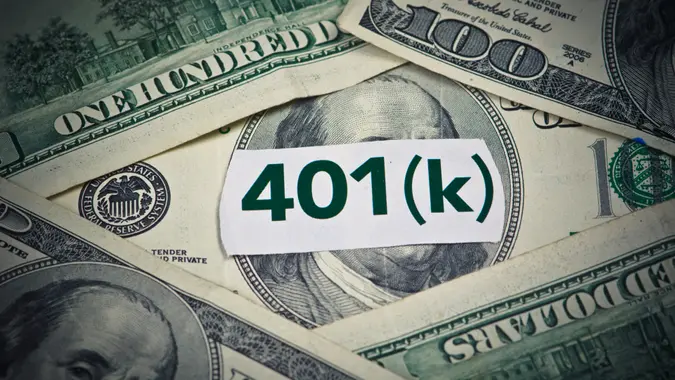5 Budget Stretchers To Get You Closer To Maxing Out Your 401(k)

Commitment to Our Readers
GOBankingRates' editorial team is committed to bringing you unbiased reviews and information. We use data-driven methodologies to evaluate financial products and services - our reviews and ratings are not influenced by advertisers. You can read more about our editorial guidelines and our products and services review methodology.

20 Years
Helping You Live Richer

Reviewed
by Experts

Trusted by
Millions of Readers
You know you need to put a certain percentage into your 401(k), but you don’t make that much money. What do you do?
That’s the question GOBankingRates reader Kimberly recently submitted to our Top 100 Money Experts series. To answer it, we spoke with Andrew Latham, a certified financial planner and content director at SuperMoney.
“This is a smart and common question I hear a lot, especially from people early in their careers or managing tight budgets,” Latham said. “The truth is, you don’t need to contribute 15 or 20% of your income to a 401(k) right away to be successful. What matters most is starting with what’s realistic and building from there.”
Fortunately for Kimberly — and readers in her position — Latham offered actionable suggestions for putting as much as possible into a 401(k), and even getting closer to maxing out contributions over time.
1. Start Small — but Take Advantage of Employer Matches
Latham’s first piece of advice is to figure out how much Kimberly can contribute without straining her monthly budget. He suggests starting with 1% to 3% of her income, since even small contributions help build positive habits around saving — while allowing her to benefit from compound growth.
If her employer offers a 401(k) match, he strongly encourages her to take advantage of it. By contributing at least enough to get the full match, she’s essentially getting “free money” added to her retirement account.
“For example, if your employer matches 100% of the first 3% you contribute, and you make $45,000, that’s $1,350 per year your company will give you just for participating,” he said. “Even if your finances feel tight, contributing enough to receive the match should come before other long-term goals like extra debt payments or investing elsewhere. Think of it as part of your salary that you only get if you make that move.”
2. Audit Your Spending
Finding extra money to boost contributions may be as simple as reviewing monthly bank statements for subscriptions, recurring charges and overlooked expenses. By canceling unused services, renegotiating bills like internet or insurance, or switching to a more affordable phone plan, Kimberly might free up more money than she expects.
Latham also suggests using technology to simplify the process.
“Apps like Rocket Money and Trim can help identify opportunities to save,” he said. “Just $50 per month in savings could free up 1% to 2% of your income to put toward retirement without impacting your lifestyle much.”
3. Manage Your Debt Strategically
Addressing debt should be part of anyone’s money management plan, and Latham said it’s especially important when trying to free up cash for retirement.
He recommends looking into refinancing high-interest loans or consolidating credit card debt at lower rates if applicable.
“For example, reducing a 15% APR to 8% could lower your monthly payments by $40 or more, depending on the balance,” he said. “That money can then be redirected toward your 401(k). This doesn’t mean ignoring debt, but rather managing it in a way that frees up cash flow for other goals.”
4. When Your Income Increases, Bump Up Contributions
Just because Kimberly isn’t earning what she’d like now doesn’t mean that won’t change. If she gets a raise, bonus or new job with higher pay, Latham encourages increasing 401(k) contributions by 1% to 2%.
“If you get a 3% raise, increasing your 401(k) contribution by just 1% means you’ll still see more in your paycheck while also saving more for the future,” he said. “Many 401(k) plans allow you to automate contribution increases annually, which makes it easier to grow your savings gradually without needing to think about it.”
5. Know When To Split Your Priorities
Latham understands that Kimberly likely has multiple competing priorities. He wants her 401(k) strategy to be part of a broader financial plan that also includes emergency savings and debt reduction.
Her first step after securing an employer match should be building an emergency fund with one to three months of basic expenses. From there, he recommends aggressively tackling high-interest debt. Once that’s under control, she can refocus on increasing retirement contributions.
“The bottom line is that you don’t need to max out your 401(k) right now. In 2025, the maximum annual contribution for people under 50 is $23,500, but that’s a long-term goal,” he said. “Starting early with small amounts and increasing over time is often more effective than waiting until you have ‘enough’ to contribute a large percentage. Remember, compound interest rewards time more than size.”
He favors this balanced approach because it helps Kimberly build financial security while also ensuring she doesn’t delay saving for retirement.
Bottom Line
Latham has some parting words of wisdom for Kimberly. By being realistic about what she can save and taking a critical look at her spending and debt, she can free up more money to support her 401(k). And if an employer match is available, she shouldn’t leave it on the table.
But above all, he wants Kimberly to remember one thing: “You’re not behind. You’re just getting started, and that is the most important part.”
This article is part of GOBankingRates’ Top 100 Money Experts series, where we spotlight expert answers to the biggest financial questions Americans are asking. Have a question of your own? Share it on our hub — and you’ll be entered for a chance to win $500.
 Written by
Written by  Edited by
Edited by  Money Expert
Money Expert 

























